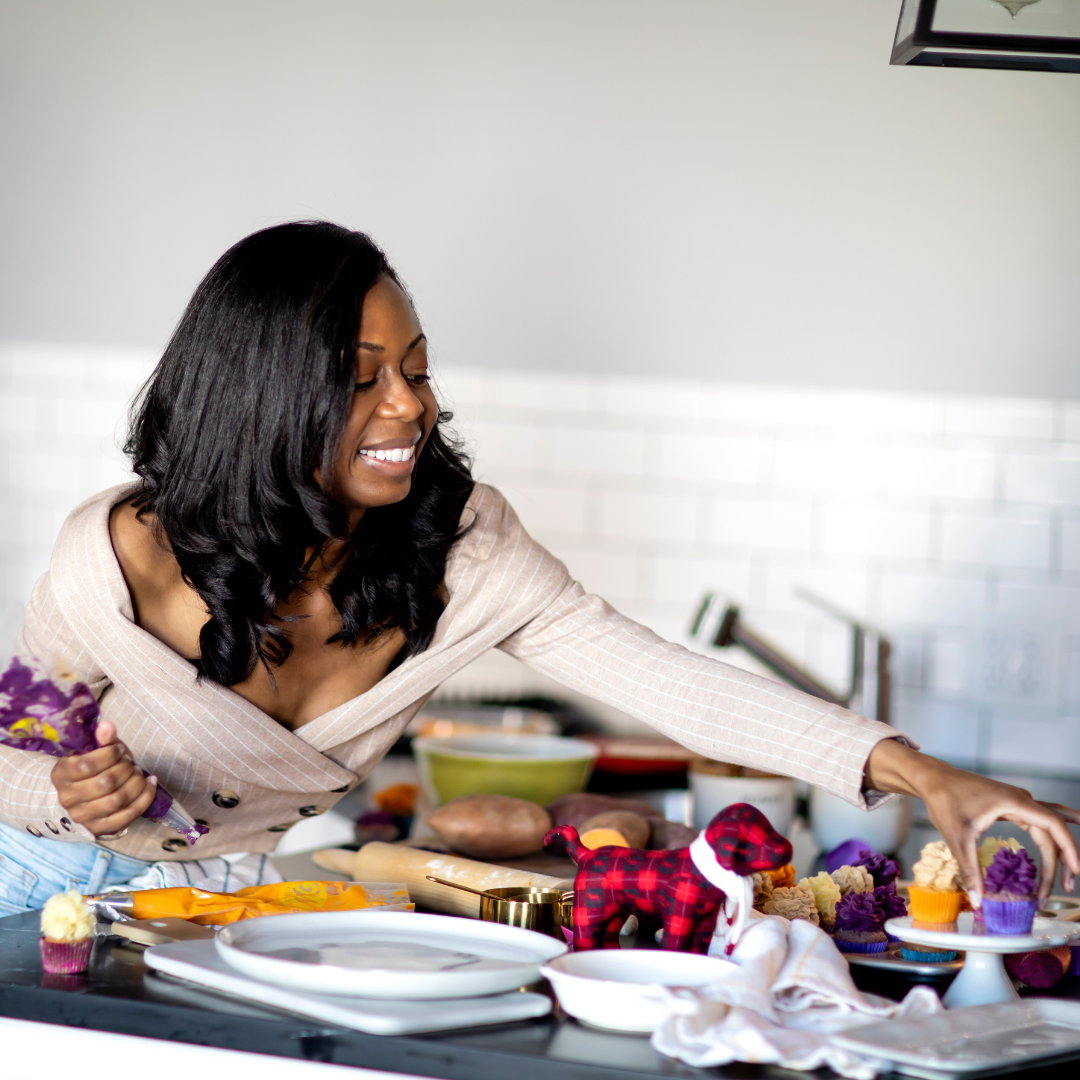
As a dog mom, I learned very early that, well…shhh…Sugar happens. It’s important to be prepared for those “Are you kidding me?” moments. Like the time Sugar leaped off the couch and hurt her paw, which led to an unexpected visit to the vet (and a bill).
I decided that I needed to save for the unexpected before it happened. So, I started my “Oh Shhh…Sugar” fund, saving a little money each week to take care of those unexpected pet expenses. One of my strategies to save was cooking more meals at home.
In this blog post, we’re looking at how much we can save from cooking at home.
THE TRUE COST OF EATING OUT
Capital One Shopping published their Millennial Shopping Statistics, which state that millennials spend approximately $325 a month dining out and approximately $490 a month on groceries. The costs of eating out can add up, especially after you add sales tax, delivery charges, food app transaction fees, and tips.
After looking at my budget, I realized that I easily spent $40 to $50 a week eating out for lunch, which was $160 to $200 per month. That was fine before Sugar became a part of my family. But with these new dog mom expenses, $200 a month seemed like a lot more than it used to be.
So, I did the math. One of my go-to lunches at work was a sandwich from a local sandwich shop near my office. Between the sandwich, chips, and a drink, I could easily spend $8 to $10 per day. I thought if I could recreate the same meals at home, I might save a little more money for my “Oh Shhh…Sugar” fund.
Buying all the ingredients from the store and making it at home cost me $60. Plus, the ingredients lasted for a month’s worth of work lunches, which led to $100 to $140 in savings with the exact same meal. Plus, I realized that my sandwich was better than the local shop I purchased my lunch from every day.
Also note that there are several different variables, such as location, taxes, ingredients, menu, time, etc., that can affect the cost calculation for your food. There might also be some initial costs associated with purchasing ingredients for your meals.
BENEFITS BEYOND THE FINANCIAL SAVINGS
Cooking at home not only helps save money, but it also allows you to control the ingredients and portion sizes of your food. This can help with making healthier choices for your meals. Cooking and eating at home can provide more opportunities to spend quality time with family, which includes spending time with your dog. Cooking at home also gives you the opportunity to be creative and can give you the chance to cook sustainably to decrease food waste.
PRACTICAL TIPS FOR COOKING AT HOME
If you’re starting from scratch, literally, you may not have a lot of ingredients in your home. It takes a minute to build a stocked kitchen, especially with the rising cost of groceries. However, here are ways to start cooking from home without breaking the bank.
Create a Basic Budget – Determine how much you can afford to spend on your groceries for a certain period (week, biweekly, month, etc.). Shop at bargain or budget-friendly markets when you can. Also, check out coupons and the local circulars to get the scoop on sales and discounts.
Start with Easy Recipes – Start with easy recipes with simple ingredients. This way you don’t have to spend a lot on ingredients all at once. It’ll also save time and be less intimidating if you’re new to cooking. If you’re going to bake for your dog, our eBook Sugar’s Dish: My Start from Scratch Story & Ten “Easy As Pupcake” Recipes to Try at Home has pupcake recipes designed for the beginner baker.
Establish a Meal Plan – Create a meal plan for the week. Then purchase the items you need that will work for the meal plan for breakfast, lunch, and dinner. It’ll also help you think strategically about what you’re eating and be intentional about where you spend your money to buy it.
Create a Grocery List – Create your list of items before you go to the store. You can do it on your phone or write it on a piece of paper. Then stick to that list. If it’s not on your list, don’t buy it. This will help you stay on budget and reduce the temptation to make impulse buys. Also, avoid shopping while you’re hungry. Grocery shopping while you’re hungry often leads to purchasing more food items, especially if you walk past that sample tray.
Buy in Bulk – Purchase staple items, such as grains and beans, and frozen vegetables in bulk to save money. This is where storage space is extremely important. Buying in bulk is great, but you want to make sure that you don’t buy so much that you don’t have any place to store it. Buying too much can be a waste of food and money.
Purchase Seasonal Products – Seasonal fruits and vegetables are often cheaper and fresher. They are also easier to find when shopping.
THINGS YOU CAN DO WITH YOUR SAVINGS
So, now that you’re cooking (literally), it’s important to have a plan for the money you’re saving. If not, it’s easy to spend your savings unintentionally. The important thing is to use the savings for something that is important to you. It’ll help you stay on track for your savings journey and make cooking from home more memorable. Here are four ideas for using your savings:
Build an Emergency Fund – Set aside a portion of your savings to create a financial cushion for unexpected expenses.
Pay Off Debt – Use your savings to make extra payments on high-interest debt, reducing the overall interest paid and freeing up more money in the long run.
Invest in Personal Growth – Spend on courses, books, or hobbies that enhance your skills and bring you joy. Some of these personal growth activities can also lead you to more opportunities to create new streams of income.
Save for Future Pet-Related Expenses – Prepare for future vet visits, pet insurance, or unexpected pet health issues.
HOW TO CALCULATE YOUR TRUE SAVINGS
Saving money from cooking at home varies. There are several variables that can contribute to the actual savings. Variables include taxes, location, ingredients, etc. Here are a few ways to help you determine how much money you really can save:
Track Your Dining Out Spending: Record all your dining out and grocery expenses for one month. Add up your total dining out expenses and your grocery expenses. Subtract your total grocery expenses from your total dining out expenses to see your potential savings.
Comparison Meals: Compare the cost of buying the ingredients to make your favorite meal with the cost of buying it. This will give you a chance to see the true savings like I did with my lunch example.
Include Investment Costs: Cooking from home usually requires an initial investment for ingredients, supplies, etc., that you may not have in your kitchen. So, if you’re starting from scratch you may not see the biggest savings right away. However, think long-term when it comes to this. Measure how much money you’ll save over a longer period (i.e., 3 months, 6 months, etc.).
Opportunity Costs: Opportunity cost is the time you spend cooking that you can spend on something else productive. So, make sure that you account for the time it will take you to cook from home. This is why it’s more beneficial to start small. Cooking big extravagant meals can be intimidating to a new cook or if you don’t have a lot of time.
Example:
- Monthly Dining Out Expenses: $320
- Monthly Grocery Expenses: $200
- Monthly Savings: $320 – $200 = $120
- Annual Savings: $120 x 12 = $1,440
These savings can be redirected towards your financial goals, such as building an emergency fund, paying off debt, or investing in your future.
Cooking from home does offer some cost and time savings. I’ve learned that it’s more than just functional, but it’s a great way to be intentional about your self-care. The key is to keep it simple. Start off small with bite size steps and enjoy the journey. You’ll not only save money and time, but you’ll also get the chance to create with food.
Now, we’d also love to hear from you. What are 5 things you can do with your extra savings? Share your stories and connect with us @pupcakesugar.
If you’re looking to bake your dog treat or your still on the fence about trying, we’ve got you covered. Sign up for the Pupcake Sugar mailing list to get Sugar’s favorite birthday pupcake recipe to try at home with your dog. It’s great for dog moms who are new to baking dog treat.
Also, check out the Shop page for more of Sugar’s pupcake recipes and the stories that inspired them.
You’ll also get a chance to step into Sugar’s world. I love my dog, Sugar, and her daily shenanigans make me laugh. So, I created an illustrated character inspired by her and her love of pupcakes. Sugar’s character is a “pupcakepreneur” that owns and operates her own pupcakery called Pupcake Sugar. It’s a tongue twister, but it’s amazing what you can create when you let your imagination lead the way.


